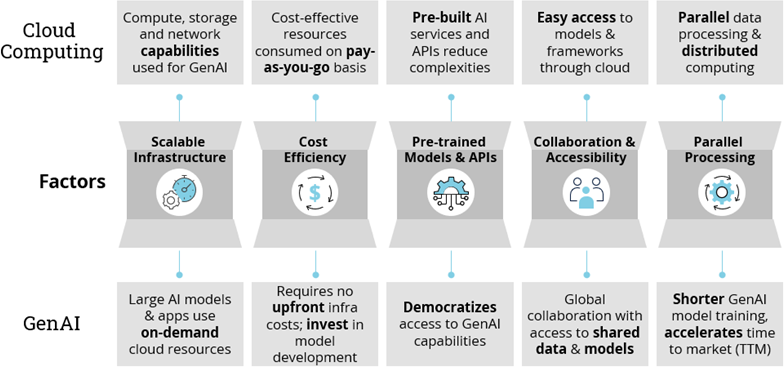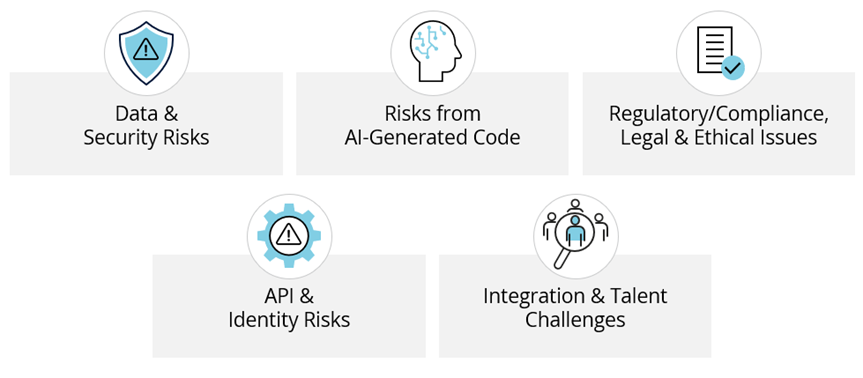In the rapidly evolving technological landscape, generative AI (GenAI) is emerging as a vital driver for cloud investments across global enterprises. This transformation is not only reshaping cloud adoption strategies but also fostering innovation in various sectors.
What is the influence of GenAI on enterprise investments in the cloud? And what are the challenges and risks associated with its implementation? Now is the time for enterprises and ecosystem stakeholders to be strategic.
GenAI as a Catalyst for Cloud Investments
GenAI is rapidly becoming a major driver of cloud investments around the world. Recent industry reports indicate that the GenAI market is currently valued at $44.89 billion, with projections suggesting exponential growth to $1.3 trillion by 2032. This burgeoning market is expected to generate $280 billion in new software revenue, highlighting its potential to reshape IT landscapes. Key indicators show that the adoption of GenAI will significantly fuel cloud spending, with notable growth in markets such as Europe, where the value is projected to increase sixfold by 2027.

Figure 1: How GenAI Boosts Cloud Spending
The increasing reliance on GenAI tools and applications necessitates scalable and robust cloud infrastructure, which are crucial for supporting the heavy computational demands of GenAI models. This dependency is prompting organizations to invest heavily in cloud solutions, reinforcing the role of GenAI as a catalyst for cloud investments.
The Symbiotic Relationship Between GenAI and Cloud Technologies
Cloud computing and GenAI are intertwined in a way that maximizes the potential of both technologies, creating a powerful ecosystem that fosters innovation and growth. It is important to explore this symbiotic relationship in greater depth.

Figure 2: A Symbiotic Relationship Between GenAI and Cloud
5 Factors that Connect GenAI and Cloud Technologies
Scalable infrastructure: GenAI relies heavily on enormous computational power for tasks such as training large models and running inferences. Cloud platforms, with their on-demand and scalable infrastructure, are perfectly suited to meet these needs. Organizations can effortlessly scale their resources up or down based on their requirements, allowing them to access advanced computational units like graphics processing units (GPUs) and tensor processing units (TPUs) without the burden of hefty initial investments. This flexibility not only increases efficiency but also empowers companies to focus their resources on developing innovative applications rather than managing infrastructure.
Cost efficiency: The financial implications of implementing GenAI can be daunting without the right infrastructure. However, by tapping into cloud resources, businesses can significantly lower their barriers to entry. Cloud computing allows enterprises to experiment with GenAI technologies on a pay-as-you-go basis, eliminating the necessity for substantial upfront Capex investments. This model encourages a culture of experimentation and agility, enabling companies to test out new ideas and scale successful projects without the fear of overspending.
Pre-trained models and APIs: One of the remarkable advantages of cloud computing is the availability of pre-trained models and APIs offered by cloud providers. These resources democratize access to advanced AI capabilities, allowing businesses of all sizes to integrate GenAI solutions into their operations with ease. Companies can leverage these tools to enhance their applications, improve customer experiences and derive insights from their data without needing deep expertise in AI.
Collaboration and accessibility: The collaborative nature of cloud platforms plays a crucial role in the advancement of GenAI. By providing a centralized environment where data and models can be shared, cloud computing facilitates global collaboration among researchers, developers and organizations. This accessibility means that innovative ideas can emerge from anywhere in the world, as teams can work together seamlessly, regardless of geographical barriers. Such collaboration accelerates the pace of innovation and drive advancements in GenAI technologies.
Parallel processing: The distributed computing capabilities inherent in cloud environments significantly enhance the training process for GenAI models. By enabling parallel processing, cloud computing reduces the time required to train complex models, which in turn accelerates time to market (TTM) for new applications. This efficiency allows businesses to respond quickly to market demands and deploy AI solutions faster than ever before.
The intricate relationship between cloud computing and GenAI is driving innovation for enterprise IT. Cloud computing acts as a vital enabler for GenAI, providing the necessary infrastructure, cost efficiency, resources, collaboration opportunities and processing capabilities that allow organizations to thrive in this rapidly evolving field. Embracing this synergy not only enhances the capabilities of both technologies but also paves the way for groundbreaking advancements that can reshape industries and improve lives.
Please fill out this form to continue.
Key Risks and Challenges That Could Make or Break Success
While the integration of GenAI in cloud platforms presents significant benefits, it is essential to recognize and address several critical risks and challenges that accompany it.

Figure 3: Challenges and Risks Related to Cloud Security, Data Governance & AI Ethics
Enterprises should be prepared for the following five challenges:
- Data and security risks: As organizations increasingly rely on large datasets for training AI systems, maintaining data privacy and ensuring robust security measures becomes a significant challenge. Organizations must implement advanced encryption techniques, access controls and regular audits to safeguard sensitive information.
- AI-generated code vulnerabilities: There is growing concern among organizations regarding the vulnerabilities that may arise from AI-generated code. Such vulnerabilities can potentially lead to security breaches and expose systems to AI-powered attacks. Developers need to adopt rigorous testing and validation processes for AI-generated outputs to mitigate these risks effectively.
- Regulatory and ethical issues: Compliance with data protection regulations is vital as organizations adopt GenAI technologies. Moreover, there is a pressing need to prevent the malicious use of GenAI models, which can lead to ethical dilemmas and societal harm. Organizations should establish comprehensive ethical guidelines and conduct regular assessments to ensure that their use of GenAI aligns with regulatory requirements and ethical standards.
- API and identity risks: The integration of GenAI into cloud platforms often involves the use of APIs, which can be vulnerable if not secured properly. Additionally, fragmented identity management systems can create significant threats to the integrity of cloud-integrated GenAI solutions. Organizations must prioritize the implementation of secure API management practices and unified identity management solutions to reduce these risks.
- Integration and talent shortages: The successful integration of GenAI with existing IT infrastructure necessitates specialized skills and expertise, which are currently in high demand and short supply. Organizations may face challenges in recruiting and retaining talent capable of effectively managing these technologies. To overcome this hurdle, businesses should invest in training programs to upskill their current workforce and explore partnerships with educational institutions to cultivate a new generation of skilled professionals.
To effectively mitigate these risks, organizations must carefully select cloud service providers, implement robust security measures and establish governance practices that ensure the reliability, safety and ethical use of GenAI technologies. By proactively addressing these challenges, organizations can leverage the transformative potential of GenAI while minimizing associated risks.
How Should Ecosystem Stakeholders Respond?
Different ecosystem stakeholders have different responsibilities.
Cloud Providers:
- Facilitate model deployment and lifecycle management: Cloud providers need to develop sophisticated tools that facilitate seamless model deployment and continuous monitoring. Such tools are essential to uphold governance in GenAI applications and ensure that models remain compliant and effective throughout their lifecycle.
- Enhance infrastructure and R&D investment: To meet the evolving demands of GenAI, cloud providers should enhance their infrastructure capabilities. This includes investing in research and development to deliver superior performance and cost efficiency, which are crucial for organizations looking to effectively leverage GenAI technology.
AI-Model Providers:
- Foster knowledge transfer and data governance: AI-model providers play a vital role in facilitating the transfer of expertise and establishing robust data governance frameworks. This ensures that organizations can maintain high standards of quality and compliance, ultimately fostering trust in GenAI solutions.
Enterprises:
- Identify use cases and experiment: Enterprises should concentrate on identifying specific use cases that align strategically with their organizational goals and risk profiles. This targeted approach enables more effective experimentation and integration of GenAI into business processes.
- Manage risk with a focus on value: A critical aspect for enterprises is to prioritize clear objectives that emphasize transparency in the implications of security and privacy. By maintaining a strong focus on risk management, organizations can better navigate the complexities associated with GenAI technologies while maximizing their potential value.

Unlocking Value: Harnessing the Power of Cloud and GenAI Synergies
Enterprises must strategically position themselves to harness the transformative benefits offered by cloud computing and GenAI. Implementing foundational elements that promote synergy between these two domains is essential for maximizing potential.
1. Develop robust data governance and security processes:
- It is imperative for enterprises to establish comprehensive data management frameworks that prioritize robust cybersecurity protocols. A well-defined data governance strategy ensures that data integrity is maintained while safeguarding sensitive information.
- Furthermore, compliance with legal and regulatory standards must be at the forefront of these efforts. Protecting confidential data not only mitigates risks but also fosters trust among stakeholders and customers.
2. Workforce skilling and development programs:
- Identifying and cultivating the necessary skills and knowledge required to effectively use cloud computing resources and GenAI capabilities is crucial for the successful implementation of these technologies.
- Enterprises should undertake initiatives to initiate upskilling and reskilling programs, equipping their workforce with the competencies needed to navigate and innovate within the cloud and AI ecosystem. A capable and creatively empowered workforce will be instrumental in driving organizational success in an increasingly digital world.
3. Establish alliances with reputable and proven providers:
- Collaborating with established vendors who possess a strong track record and proven expertise is vital for optimizing the integration of cloud and GenAI technologies.
- These partnerships can leverage cutting-edge data solutions and resources, facilitating efficient deployments in a landscape characterized by rapid technological advancement and shifting market dynamics. Such alliances can provide enterprises with the competitive edge necessary to thrive.

Figure 4: How to Unlock the Value of Cloud and GenAI
As the capabilities of GenAI continue to advance, its impact on cloud adoption and investment strategies is expected to intensify. This evolution will not only reshape the IT landscape but also redefine operational paradigms across various industries. Enterprises that proactively embrace these changes and prioritize strategic investments in cloud and GenAI will be well-positioned to leverage the full spectrum of benefits these technologies offer, ultimately driving value creation and sustainable growth.
ISG helps organizations harness the power of GenAI and cloud computing. By fostering partnerships with reputable providers and emphasizing value creation across the IT landscape, ISG provides essential guidance in aligning technology initiatives with business objectives, ensuring sustainable growth and competitive advantage in a rapidly evolving digital environment.
